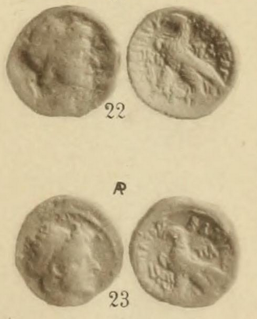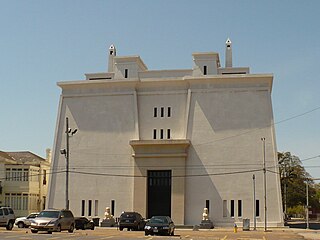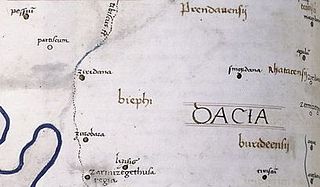
The Ptolemaic dynasty, sometimes also known as the Lagids or Lagidae, was a Macedonian Greek royal family, which ruled the Ptolemaic Kingdom in Egypt during the Hellenistic period. Their rule lasted for 275 years, from 305 to 30 BC. They were the last dynasty of ancient Egypt.

Ptolemy I Soter was a companion and historian of Alexander the Great who succeeded to his empire. Ptolemy became ruler of Egypt and founded the Ptolemaic dynasty which ruled it for the next three centuries, turning Egypt into a Hellenistic kingdom and Alexandria into a center of Greek culture.

Ptolemy II Philadelphus was the king of Ptolemaic Egypt from 283 to 246 BCE. He was the son of Ptolemy I Soter, the Macedonian Greek general of Alexander the Great who founded the Ptolemaic Kingdom after the death of Alexander, and queen Berenice I, originally from Macedon in northern Greece.

Ptolemy VI Philometor ; c. 186–145 BC) was a king of Egypt from the Ptolemaic period. He reigned from 180 to 164 BC and from 163 to 145 BC.

The Almagest is a 2nd-century Greek-language mathematical and astronomical treatise on the apparent motions of the stars and planetary paths, written by Claudius Ptolemy. One of the most influential scientific texts of all time, its geocentric model was accepted for more than 1200 years from its origin in Hellenistic Alexandria, in the medieval Byzantine and Islamic worlds, and in Western Europe through the Middle Ages and early Renaissance until Copernicus.

Ptolemy Neos Dionysos Theos Philopator Theos Philadelphos was a pharaoh of the Ptolemaic dynasty of Ancient Egypt. He was commonly known as Auletes, referring to the king's love of playing the flute in Dionysian festivals.

Ptolemy Apion or simply known as Apion was the last Greek King of Cyrene and was a member of the Ptolemaic dynasty. Ptolemy was Greek and native Egyptian in descent. His second name Apion is a name of ancient Egyptian origin and could be a name from his maternal ancestry.
Ptolemy XI Alexander II was a member of the Ptolemaic dynasty who ruled Egypt for a few days in 80 BC.
Ptolemy X Alexander I was King of Egypt from 110 BC to 109 BC and 107 BC till his death in 88 BC, in co-regency with his mother Cleopatra III until 101 BC, and then possibly with his niece-wife Berenice III.
The Chasuarii were an ancient Germanic tribe known from the reports of authors writing in the time of the Roman empire. They lived somewhere to the east and north of the Rhine, near the modern river Hase, which feeds into the Ems. This means they lived near modern Osnabrück.
The Dulgubnii are a Germanic tribe mentioned in Tacitus' Germania as living in what is today northwest Germany. Tacitus describes them being to the north of the Angrivarii and Chamavi, and as having moved from the north into the area once belonging to the Bructeri, between Ems, Lippe, and Weser. In this same area as the Dulgubnii, north of the Chamavi and Angrivarii, were the Chasuarii, and north of these, on the North Sea coast, where the Chauci. The Chasuarii's name is thought to derive from the River Hase which feeds into the middle of the Ems from the east, just northwest of the area associated with the Angrivarii, on the Weser. So from Tacitus it appears that the Dulgubnii probably lived near the Weser.
The Canon of Kings was a dated list of kings used by ancient astronomers as a convenient means to date astronomical phenomena, such as eclipses. The Canon was preserved by the astronomer Claudius Ptolemy, and is thus known sometimes as Ptolemy's Canon. It is one of the most important bases for our knowledge of ancient chronology.

The Ptolemaic Kingdom was a Hellenistic kingdom based in ancient Egypt. It was ruled by the Ptolemaic dynasty, which started with Ptolemy I Soter's accession after the death of Alexander the Great in 323 BC and which ended with the death of Cleopatra and the Roman conquest in 30 BC.

Scottish Rite Temple, also known as The Temple Downtown, is a historic former masonic building in Mobile, Alabama, United States. It was built to serve as the meeting place for the Ancient and Accepted Scottish Rite of Freemasonry. The building was designed by George Bigelow Rogers, a local Mobile architect who was responsible for designing many of the city's buildings during this period. The cornerstone was laid on November 30, 1921, with the building completed in 1922. It is the only intact example of the Egyptian Revival style in Mobile. It was placed on the National Register of Historic Places on January 5, 1984. It was sold in 1996 to a private citizen and reopened as a banqueting venue.
The Gangani (Γαγγανοι) were a people of ancient Ireland who are referred to in Ptolemy's 2nd century Geography as living in the south-west of the island, probably near the mouth of the River Shannon, between the Auteini to the north and the Uellabori to the south. There appears to have been a people of the same name in north-west Wales, as Ptolemy calls the Llŷn Peninsula the "promontory of the Gangani".

The Creones were a people of ancient Britain, known only from a single mention of them by the geographer Ptolemy c. 150. From his general description and the approximate locations of their neighbors, their territory was along the western coast of Scotland, south of the Isle of Skye and north of the Isle of Mull. Ptolemy does not provide them with a town or principal place.

Zurobara was a Dacian town located in today's Banat region in Romania. It is positioned by the Tibiscus river, north of Zarmizegethusa Regia and south of Ziridava. It was near the Tisza river, in the area of the Dacian tribe of Biephi.
Setidava, mentioned by Ptolemy in his Geography, was a Dacian outpost in north central Europe. This town, with the typical Dacian location name ending of -dava, was mentioned in Ptolemy's Germania, who placed it north of Calisia (Kalisia), which is probably located at the present-day town of Kalisz, in Poland. Setidava was not far from the Warta River; most likely it was located in present-day Żnin.

Tibiscum was a Dacian town mentioned by Ptolemy, later a Roman castra and municipium. The ruins of the ancient settlement are located in Jupa, Caraş-Severin County, Romania.













